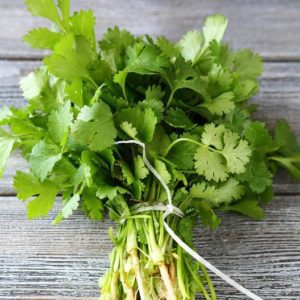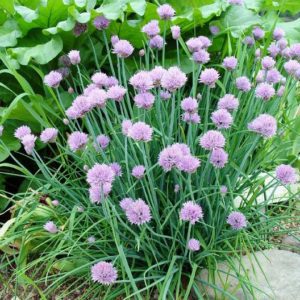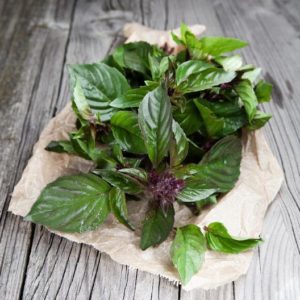The long, hot days of summer are starting to come to an end, and with August right around the corner, cooler weather will be here before we know it. As we head into the transition out of summer and into fall, now is the time to begin thinking about the fall gardening season. Selecting the right types of herbs for a fall harvest will not only be rewarding in your garden, but also at your dinner table! Below are some of the best Herbs to get started planting in late summer/early fall and will be ready for you to use before the first frost comes to town.
Cilantro
Perfect for the cooler weather, this herb prefers partial shade, and moist soil. Generally a fully mature plant will take about 50 days and will grow 6-10 inches tall. The leaves of the cilantro plant are fan shaped and closely resemble parsley. Cilantro will do best in a container, and makes for a great companion for basil. Both herbs appreciate moist soil, and will mature around the same time.

Rosemary
Another easy to grow herb that prefers full sunlight, and cooler temperatures, this essential herb will grow between 24-36 inches at full maturity. A member of the mint family, this is a great culinary herb that will add a punch to any meal. Its unmistakable fragrance is best when used fresh, but can also be dried out and stored for use throughout the winter. Rosemary is a great companion plant for cold-weather vegetables like cauliflower and cabbage, since it’s strong fragrance will repel cabbage butterflies, along with a variety of beetles and flies that can wreak havoc on your fall crops. Keep your rosemary plants far away from any squashes or pumpkins, as they do not make for good companions as they both compete for space and nutrients in the soil.
Thyme
An aromatic, culinary wonder, this herb is suited for full sun to partial shade environments, and will grow between 12-15 inches at full maturity. This very aromatic herb enhances any meat, soup or egg dish you’ll whip up as the temperature begins to drop. The tiny-leaved evergreen herb has been a staple of the culinary world for its flavorful punch it adds. Plant thyme at the end of each row of strawberries, or nearby cabbage, as it not only repels cabbage worms and flea beetles, but will also attract honeybees to your garden, aiding in pollination of strawberries and other flowering plants.
Chives
This waxy, grass-like herb closely resembles the flavor of an onion, but is much smaller in size. Mature plants will generally grow to 8 to 12 inches. Don’t be thrown off by the compact look of this herb, as it packs a powerful flavor for its size. The thin, tubular leaves are a perfect addition for many soups and potato dishes you’ll be making this fall. Feel free to harvest your chives more often than the other herbs in your garden, it will actually encourage them to grow back in even greater numbers. They also make for a great companion planting when growing carrots in your fall garden, as the presence of chives will help to repel carrot rust flies.

Mint
Another easy to grow herb that is a staple in many dishes, and will grow quite tall at 1 to 2 feet tall. Mint does have a tendency to grow fast, and wild, so it is best suited for a pot or container if you don’t want it to spread through the garden. Whether you’re growing mint in a pot or in your garden, it will requite regular feeding, and will benefit from being picked back every week or two to encourage new growth. The unmistakable smell and green leafy appearance of this herb make it a perfect to chop and add to many cocktails and desserts.
Arugula
Yes, you’re right, arugula isn’t a herb. We wanted to add it to the list because of it’s massive production potential as gardeners await lettuces and cabbages to grow to maturity later in the fall. This fast growing, cool season green is generally ready to start being harvested within 21 days, while a fully mature plant is ready in about 40 days. It’s best to harvest arugula leaves when they are smaller, before the flavor over-develops into a less than desirable taste. The white flowery oval leaved green packs a musky smell with a hint of spice. Cooler temperatures, full sun, and keeping it well watered are best way to help your arugula plant to mature quickly. Ideally, the plant will grow to between 6 to 12 inches tall.
Sage
Best when grown in an area that will receive a lot of sunlight, this plant will reach a height of 2-3 feet tall when fully mature. The green, rough leaves of the sage plant are a perfect compliment for many fish dishes as well as any meat dishes this fall. Sage is one of the few herbs on this list that is easy to grow from seed, just be sure to sow them in well-drained soil, since sage definitely does not like wet roots!
Basil
A staple in any fall garden, this strong herb is delightful when chopped fine, will add a punch to any dish you prepare this fall. Usually 6-8 hours of sun a day is perfect for this herb, once the plant reaches 6-8 inches tall it is ready to be harvested. This fall, pop your basil plants in a container that they can share with a few cilantro plants. The aromas put out by that herb combo in one container will be intoxicating.

Oregano
This Greek herb will grow anywhere from 6 inches all the way to two feet in height. The beautiful green- grey leaves that the plant produces are a perfect accent to any sauce, are is a special treat to use as a topping on homemade pizzas made from ingredients from your garden. While oregano doesn’t have any beneficial relationships with other herbs or vegetables as a companion planting, it does perform well as a pest deterrent. It’s low to the ground growth habits make it a viable candidate for interplanting with pumpkins, squash, kale, and cabbage.
Parsley
A very versatile herb that comes in 2 forms, a curly and a flat- leaf form, both of which have a very strong flavor. They do have a tendency to take a while to mature, so be ready to germinate early before planting. Mostly used as a garnish, it is perfect to add to stews and meat dishes to really blend the flavor of any herb added as well. Be sure to avoid planting any parsley nearby heads of lettuce that are growing in your garden, as it can cause the lettuce to bolt prematurely. It should also be planted far away from carrot crops, as the two plants can potentially cross-pollinate and ruin your carrots.
Fennel
This herb is has a sweeter taste than most of the herbs listed above and a perfect compliment for many of your fish meals. A tall plant, it will mature at 3 to 5 feet tall, and will closely resemble a dill plant with dark green flower-like foliage. Due to it’s strong aroma while growing, fennel is best grown in a container, away from other herbs. An old gardening saying about fennel goes “plant your fennel near your kennel”, as it’s said that fennels strong scent is a repellent for fleas.